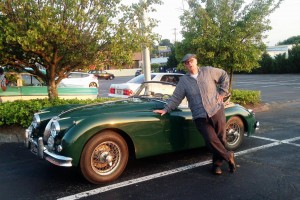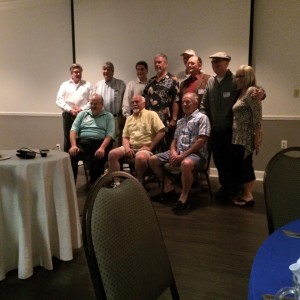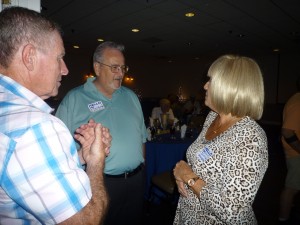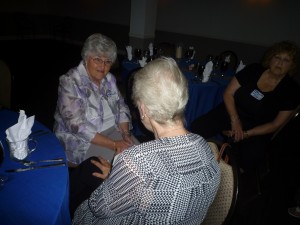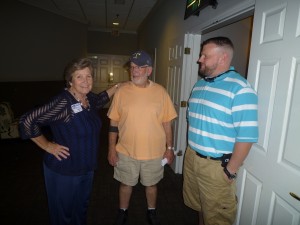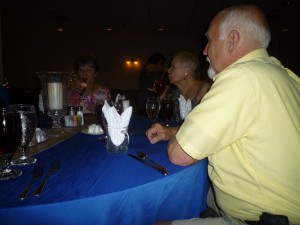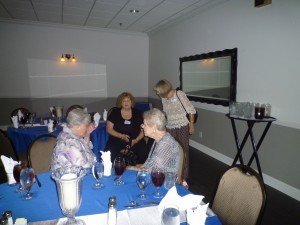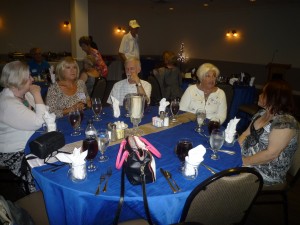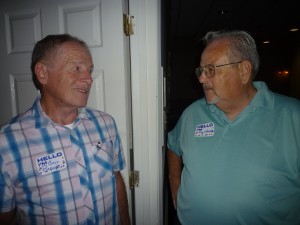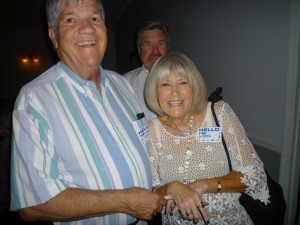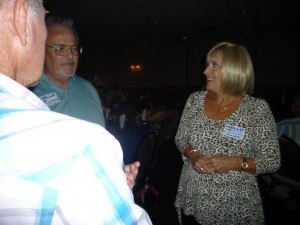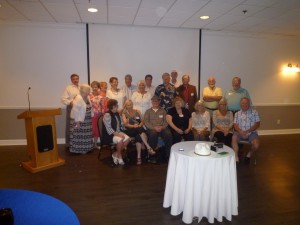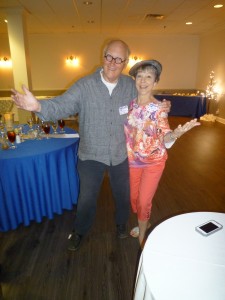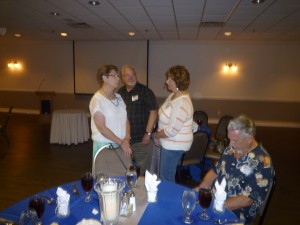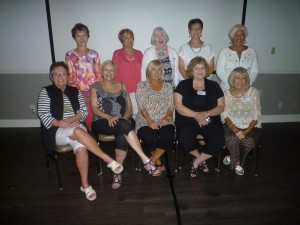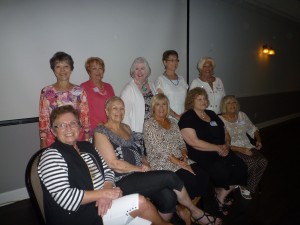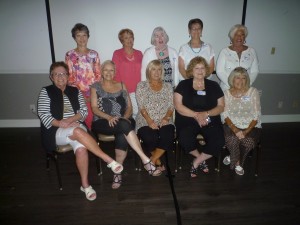Norma showed up at my grandparents’ house sometime in the late 1940s. In her teens, she had left her home in rural southwestern Virginia the day before, catching the bus to Knoxville in hopes of finding a job.
The trip was Norma’s first to Knoxville, and she had exited the bus when it reached Burlington, mistakenly believing the business bustle she was seeing meant that she had reached the city. The highway, U.S. 11, became Magnolia Avenue at Burlington, morphing into a prosperous-looking four-lane. She was unaware that she was still several miles from downtown. Noticing a help-wanted sign in the window of Kay’s ice-cream parlor at Magnolia and Crawford Avenue, she walked in and applied. She was immediately hired as counter help.
Next, she needed a place to live, and my grandparents’ house was only a block from her new place of employment.
My grandmother let Norma stay in her spare bedroom, and she helped around the house for her board. Soon, she was helping my mother, who was trying to manage me, a handful like most toddlers, and my new baby sister. Norma began spending a lot of time at our place, within walking distance of my grandparents’ house. And she soon added another job, working the night shift at Standard Knitting Mills – she could get there on the city bus that stopped in front of Kay’s, exiting at Winona Street and walking a few blocks north to the Standard plant.
I was too young to understand all this, and my memories of Norma from that time aren’t clear. But I knew that she was important to our household, and to my grandmother’s as well.
But Norma’s ambition went beyond the mill and the ice-cream counter. She saved her money until she had enough to enroll in beauty school. By the time I was a student at Park Junior High School in Park City, she had married and was the proprietor of her own beauty salon in Burlington. Soon, she was rearing her own family.
Years later, my mother and dad provided details about Norma, whose tale was typical of the time and place. It was a hard-scrabble story of want, ambition and determination.
Norma Jean Lee had grown up in Rose Hill, Virginia, and did not see a future in what was around her. Belying its name, Rose Hill is a mean stop in coal-mining country, another ridge-side Appalachian hamlet where residents eke out a living as best they can. There were several brothers and sisters. And, according to my mother, the family did not want Norma Jean heading south to the metropolis of Knoxville.
A couple of months after her arrival in Burlington, my dad said, Norma was confronted by her mother, who had ridden the bus to Knoxville to take her daughter back home. Norma refused and there were shouts and then tears. When her mother left, my dad remembered, Norma looked at him and said, “I don’t care if they do come after me, I’m never going back to Rose Hill.”
Next, a younger sister came down to see if she could persuade Norma to return. She succumbed to Knoxville’s city charms.
“Norma took her on the bus downtown to the movie at the Tennessee Theater,” my mother said. “They got caught in the rain, and got soaked. Norma’s sister only had the dress she was wearing, so she had to stay another day until her dress dried out.” She caught the Trailways back to Rose Hill the next day, returning without her sister.
Appalachia’s isolated hills and valleys are dotted with Rose Hills, places where the rock-encrusted land surrendered a limited living to its occupiers, grudgingly providing just enough for a family to survive. The jobs that were available – involving coal primarily – were backbreaking and dangerous. Post-World War II, many of the natives had witnessed the larger world and wanted a piece of it.
Many, like Norma, were successful in escaping, even if was only a hundred miles away to Knoxville, the unofficial capital of Appalachia. True to her vow, Norma only returned when she died in 1991, aged 62, to be buried in Rose Hill’s Daniels Cemetery.
The founding of the zoo
Two of my uncles, with assistance from a couple of baby alligators, founded Knoxville’s zoo. At least, that’s the story my mother told me. But I don’t want to mislead – the founding came about not as a noble act aimed at educating the general population. It happened as the result of a prank.
My mother and her four brothers grew up in Burlington, on Lakeside Street, the short thoroughfare that forms the eastern boundary of Chilhowee Park. So they had a vast playground, complete with its own body of water, Lake Ottosee. The park had wildlife – songbirds and ducks and fish. So my uncles can be forgiven for thinking that alligators would be a natural, if not altogether welcome, addition.
One summer in the late 1930s. as my mother told the story, Uncle Kenneth and Uncle Maynard, then in their late teens, made a trip to Florida. There, they discovered tourist stops that sold live baby alligators. And they decided that alligator mississipiensis would be right at home in Burlington. Their motives, as my mother related them, were completely innocent. She contended that they did not think of introducing them into Lake Ottosee, that they believed that my grandmother would welcome them into the household. Besides, she said, they were not thinking about the gators multiplying – they thought both babies were male, even naming them Kenneth and Maynard. Or maybe it was my grandmother who bestowed the monikers. My mother said she could not remember for sure.
But conversations that I had with my uncles when I was a teen-ager made me think that their intent was more devious, that, from the beginning, they saw the lake as the natural home for the pair.
Understandably, my grandmother wasn’t enamored of the horny new arrivals. A dog and a cat were pets enough, she reasoned. (The chickens that had the run of the backyard were not pets – they were there to supply food.) So, before they had time to make friends with the dog and cat, before they had grown enough to take more than a passing interest in the chickens, the gators were transported to the lake and set free.
Initially, it being summer and the water being studded with fuzzy ducklings, Kenneth and Maynard had easy pickings at mealtime. But as the ducklings – and the gators – matured mealtime became noisier, with whipping tails and panicky squawking and feathery splashing. Children fishing from the banks for sunfish took notice. Soon, Kenneth and Maynard were well on their way to becoming the stuff of urban legend.
Children and their parents informed park personnel, who were at first skeptical – until they witnessed snack-time themselves. Traps were set and the pair soon imprisoned.
But then the park’s overseers faced the problem of what to do with a couple of fast-growing alligators. An idea was hatched, and, on the hill facing the lake from the west side of the park, a pen was constructed, with a small pond and a few rocks. The alligators, at least, could view their former home, with its duck population, from their new digs.
Later, they would be joined on the hill by a pair of lions (named Romeo and Juliet), a troop of monkeys, fowl ranging from noisy guineas to showy peacocks to pushy pigeons taking advantage of the park-provided food intended for the official residents. Eventually, Ole Diamond, the elephant generally credited with being the catalyst of today’s first-rate zoological garden, would join them.
But, in my family, Kenneth and Maynard, two scaley Florida fugitives named for their rescuers, were the true founders of the zoo.
Of preachers and popes
The voice, despite being at shout volume, seemed to be disembodied, but the message was clear: If we all didn’t change our ways, we were going to Hell.
I was sitting in my car, waiting for the light to change at a busy downtown Knoxville interchange, three lanes each direction. Finally, I spotted the source of the sermon. The driver of a truck was shouting his message to everyone waiting on the red – preaching to the air.
Raised a Southern Baptist, I have heard my share of sermons, from the raised-stage pulpits of large, rigidly structured edifices and from the worn wooden floors of tiny, no-pulpit store-fronts. But this was the first I had seen delivered from the driver’s seat of a truck with its motor running. This was a man of God of singular determination – definitely qualified for my list of notable preachers.
Up until my late teens, I was a regular attendee of morning and evening services as well as Sunday School and Training Union. And the annual Vacation Bible Schools and week-long revivals. Occasionally there were dinners on the grounds, too, with fried chicken and potato salad and deviled eggs in infinite variety.
We were active in a popular Knoxville congregation.
While I was enthusiastic about the dinners, I was a reluctant attendee of the regular services and the revivals. My father was a deacon, my mother a choir member, and my siblings and I had no choice but to be in church when they were. Decisions to skip the service in favor of the soda counter at the nearby Greenlee’s Drug Store were made risky by Mom’s position in the choir. She scanned the pews to see that we were not only present, but upright and awake.
And staying awake could be a problem. The church was large enough – more than 1,000 members – that ritual took precedence over spirit, at least on Sunday mornings. Longtime members had sat through hundreds of sermons, delivered by dozens of preachers. Many were prone to dozing. There was one lanky member, habitué of the rear of the auditorium, who was well-known to me and my friends. He would nod off, his head would drift backward and his Adam’s apple would bob with his breathing. We found the sight amusing, a diversion that kept us awake.
Another diversion, usually occurring only at evening services, involved Aunt Jenny, an older choir member who would be moved to dance from her seat in the loft down to the front of the altar, choir robe swirling. We didn’t know whether to laugh or run.
Reluctant though I was about the sermonizing, I didn’t mind Vacation Bible School. My dad, a machinist who worked the second shift and was available in the mornings, would be called on for VBS, usually put in charge of crafts for the boys. And I would be drafted to help, loading pieces of plywood into the station wagon, along with the saws and files that would be used to cut them into animal shapes. They would then be decorated with colored popcorn. Sometimes, the end product would actually resemble a chicken or a rabbit – or something nightmarishly in-between. Afterward, I would wield a broom as we cleaned up the scattered popcorn.
By the time I was 12 or 13, plywood animals didn’t hold much interest for my age group. Crafts hour degenerated into popcorn battles, saws and files becoming dangerous weapons.
As I became more of a hindrance than a help, Dad enlisted another deacon. Boomer, as I’ll call him here, was an automobile mechanic, and he had an idea. He brought in several boxes of old carburetors, screwdrivers, wrenches, and a can of kerosene and shop rags for cleaning. He showed us how to disassemble the carbs, how to clean all the parts with kerosene, and how to put them back together. We worked on single-barrels, then two-barrels, and, finally, at week’s end, four-barrels. There were a lot of greasy fingers and oil-stained clothes, but no more popcorn battles.
But as I grew older and bought my own car, with its own carburetor, I moved away from active church participation, eventually working a part-time job downtown. It was then that I started taking note of street preachers. Knoxville had its share, most of them active on Saturdays on Market Square. Their breathy buildups and sing-song deliveries were fascinating, at least as a lunchtime diversion. Too, there was the young guy who was adept at leaping into the air at particular points during his sermons, jumping just as he slapped his Bible against his hand, his timing precise.
After I graduated college and changed jobs, moving from city to city, other Bible thumpers caught my attention. In downtown Dallas, there were dueling preachers who worked a particularly busy street corner. One would sermonize for a while, the other looking on in disgust. When the first ran out of steam, the second would start, his competitor watching with a disdainful look.
Atlanta featured several of note. There was a woman, part of a group that wore white robes, who would smoothly segue from preaching to singing, her “sisters” joining in on the chorus. But downtown Atlanta’s best as spectacle was an African-American man who worked Woodruff Park at lunchtime. He carried a guitar slung over his shoulder, though I never saw him play it. What made him interesting was his “shadow.” At some point, a young white man had decided to follow him closely and mimic his movements, making fun of him. The shadow became enough of a problem that a third person joined in: an Atlanta policeman who made sure the shadow didn’t get too close.
Though I found street preachers intriguing, I had long ago decided I didn’t want middlemen between me and my maker, epiphany coming when I was high-school age and still attending the church of my childhood. The educational minister was a slick, charismatic character with a wife and five children. His spouse, who sat next to my mother in the choir, was the butt of his jokes when he made his reports to the congregation on Sunday mornings. And, I overheard my mother tell her friends, she would whisper funny asides in response, using language not suited for church.
But one afternoon as Mom and her friends gossiped, I overheard a different tale about the minister. It seems that he was having an affair with a church member, also married. I didn’t hear much detail – one of Mom’s friends noticed that I was in the room and I was quickly sent outside.
The next Sunday, the educational minister and his wife were not present at either service. The word quickly spread that he had resigned and that he and his family were leaving Knoxville. Over the next couple of weeks I picked up bits and pieces of the story, but I was too involved in my own high school shenanigans to pay much attention.
The years passed, the neighborhood changed, and the church merged with another congregation. I was living in Kansas City at the time. Mom and Dad were active in the new church for a while, until the fundamentalists started taking over the Southern Baptist Convention. My parents were both strong believers in formal education, and the mail-order degrees held by the new faction appalled them.
Eventually the new church called a new preacher, a fundamentalist whose education was, as far as my mother was concerned, seriously lacking. She soon was at loggerheads with him and he fired her from the Sunday School class she was teaching, even sending a young minister-in-training to suggest that she not tell anyone why she was no longer teaching. She told him that if she was asked by any of the women in the class, she wouldn’t lie. Eventually, she and my dad quit attending.
My parents knew everyone in that area of Knoxville, and my mother, never shy, wielded considerable influence. The new preacher – she had taken to calling him Pope John – decided he needed her back in attendance. He began regular visitations at their house.
His entreaties only angered her. Finally, she told him that if she came to church it would be to call for his ouster. Under Southern Baptist Convention rules, any church member can call for a vote about a preacher at any service; if there is a second, the vote must be held then and there. Her threat was sufficient, and Pope John didn’t come around anymore.
Years later, at my father’s funeral, I spoke with many of his old friends from the old church, the shade-tree mechanics he talked cars with, fellow machinists, the neighbors he helped when their vehicles wouldn’t start. But I didn’t see Boomer.
Later, talking about the crowd with my brother and sister, I mentioned his absence. My sister looked over at me. I guess you didn’t hear, she said: He committed suicide years ago.
My look of surprise led her to explain. Boomer had had a drinking problem, a problem that became worse with the discovery that his wife was involved with the church’s educational minister.
Of Blackberries and ‘Panters”
Miz Lusby lived on the street that ran the length of the ridge that defined the southern edge of Burlington, a block or so from our house. She was, according to word around the neighborhood, a bit of a witch. Because of that reputation, and because of the tales she told, she was popular with the kids.
During warm weather, after supper when twilight was deepening, she could often be found sitting on her front porch in a rocking chair that appeared to be even older than she was. And often we would be gathered around, waiting for one of her stories.
She liked to scare us with accounts of in-house wakes, the honoree stretched out in his or her coffin in the parlor, mourners gathered around in the dim light of candles or lanterns. The memories that were shared by the mourners in attendance would invariably involve a violent act, sometimes following a mysterious night-time chase. One such chase, one of the more memorable, involved a “panter.”
Panters – panthers or cougars – were a particular favorite of Miz Lusby. Though they had not been spotted officially in East Tennessee for decades, she was sure they were still around. “A panter is smart,” she would say. “He learns how to stay away from human beings, only coming out at night to raid a barn or a pig sty, grabbing a shoat or a newborn calf for his supper.”
So, according to her, panthers were responsible for the mysterious disappearance of farm animals, or, she would imply, somebody’s dog. “They wouldn’t mess with cats,” she contended. “Some people say it’s because they’re too small, not worth messing with. But the real reason is because they’re cats, too. They’re kin, so the panter don’t mess with ‘em.”
And, she liked to emphasize, “a panter’s cry is just like a baby’s – if you ever hear one in the middle of the night, it’ll sound just like a little baby crying.” Of course we all knew the sound of the neighborhood tomcats as they made their nighttime rounds, wailing at each other, so we could easily imagine the sound of a panter. And, just to make sure we understood what she was talking about, she would demonstrate, executing a long, drawn-out cry that sounded just like a baby.
Miz Lusby was a “widow woman”. Her husband, according to neighborhood lore, had disappeared not too long after they were married, then turned up dead in Texas. Some said he had been shot. Miz Lusby had lived alone ever since, with a dog and a house cat or two. No one ever said anything about how she survived, except that she took in sewing. And she had a garden during spring and summer. We weren’t interested in such details. We only wanted to hear her tales.
Sometimes, we would ask about how to keep a panter away. She would say that it didn’t always work, but there was a spell you could use. She would then tease us. If we could find her a black-cat bone she would tell us how to use it. “It takes some practice, and it don’t always work,” she would insist, “but it’s your best chance.”
Once, Earl Presley brought her a small bone he’d found, claiming that he was sure it came from a black cat. She took one look and said, “No, that’s from a possum.”
About the time I got a decent bicycle and was getting old enough to start scoffing at her stories, she delivered the tale that topped them all. She delivered it so believably that I forgot my recently acquired skepticism and sat up and listened.
She had heard, she said, a panter the night before, and it was so close it had to be in the Holler, several acres of bushes and weeds that began only a couple hundred yards behind her house. We were all familiar with the Holler – it was full of blackberry bushes as well as rabbit tobacco and hidden spots for smoking it.
Eyes widened as she demonstrated the panter’s cry, and provided details of her two cats trying to get out of her house when the wailing began. “They were wanting to go join it, I reckon,” she said. “I didn’t sleep another wink, I can tell you.”
Then, a few days later, at the height of blackberry season, I saw Miz Lusby in the Holler, busy filling a pan with berries. She had the entire place to herself, all the kids staying away lest there be a panter present.
A baptism into religious differences
Troop 15, Boy Scouts of America, met on Thursday nights at Kirkwood Presbyterian Church, on McCalla Avenue in Burlington. The church building was small, but there was an adequate meeting room in the basement, and more importantly, a grassy back area perfect for games of “Pitch Up and Smear.”
I can’t remember the objective of the game but it involved a football that was thrown into the air, with everyone scrambling to catch it. The lucky Scout was then susceptible to a “smearing” by the others unless he could get the ball to someone else. There must have been some kind of scoring system. Understandably, not everyone present wanted to participate.
Most of us were veterans of such neighborhood “games.” But one of the kids, who was not a Burlington resident, expressed an intellectual skepticism to the game’s “point.” His name was Richard and he lived in Park City, the next neighborhood to the west, far enough away so that his dad drove him to the Scout meetings..
Worn out from the games, we would then gather in the church’s meeting room, with the scoutmaster, Jimmy Coppock, presiding. The church might have been modest, but, thanks to Mr. Coppock, the troop enjoyed a certain prestige in the Great Smoky Mountain Council of the Scouts. Mr. Coppock, a postman by day, was a longtime fixture with the organization, and holder of a Silver Beaver Award, one of Scouting’s top honors.
Though the meeting place was Presbyterian, the troop membership reflected the community, drawing from McCalla Avenue Baptist, across the street, from Burlington Methodist, a couple of blocks away, and from other churches in the area.
The troop shared ownership with another troop of a cabin on Chilhowee Mountain in the Smokies. The cabin – one long room with a porch that ran its entire length – was equipped with rustic bunk beds, a fireplace, and a wood-burning cook stove. A spring just above it on the mountain provided water. During warm weather we would spend three or four weekends there.
At that time, the late 1950s, that part of the mountain was serviced by a barely usable dirt road. At one point in the 1920s, we were told, on the Knoxville side of the peak, there had been a resort hotel called Dupont Springs. Sometimes we would hike up there and scout around its remains.
Our cabin was on the side facing Sevierville, about two-thirds of the way to the top. It was well off the dirt road, barely visible in the winter when the trees were bare. There was only one other usable cabin in the area, owned by the couple who had donated the land for the Scout facility.
The road, most of the time, was passable by car or truck, but we always hiked up, complaining most of the way, badgering Mr. Coppock with distance questions. No matter how many miles remained, his stock answer became a running joke. When asked how much farther, he always said: “Mile, mile and a half, two miles.”
Sometimes, those of us who were more experienced, who had his trust, would be allowed to hike up a creek, scrambling through the woods in an attempt to get to the cabin ahead of those using the road. Once, on a dare, Ray Merritt and I toted a watermelon, along with our usual gear, the entire three and a half miles up the road. Mr. Coppock saw to it that we shared the melon with the others even though we pointed out that none of them had volunteered to help carry it.
Later, I figured out that I could lighten my load by simplifying my diet. The only food I carried was a package or two of wieners, a loaf of bread and a jar of mustard. No cooking pans, no eating utensils. All I needed was a sharpened stick and a fire to make my hot dogs, which I ate for every meal. Mr. Coppock told me that though my thought process was admirable, I was a bad example for the younger boys.
But Mr. Coppock’s greatest lesson to us came about when the question of religion arose on one of the trips. I don’t remember how it began, but someone started talking about the difference between being a Baptist and being a Methodist or Presbyterian. Obviously, being dipped under the water was scarier than being sprinkled, so Baptist was a tougher religion. Or something like that.
Richard wasn’t participating in the argument, and someone finally asked him what religion he was. He simply said he wasn’t any of those. One of the kids pressed him, and Mr. Coppock then stepped in, explaining that Richard was Jewish and what that meant.
As I remember, there were a couple of shrugs and that was the end of it. We all took pride in the fact that Troop 15 had its own cabin in the mountains – something that most other troops did not have. But now, at least for a few of us, we had something else that set us apart, we had a Jewish member.
Zip guns and exploding toilets
My move to junior high school in many ways was more than a mere move. It was a leap. I went from the neighborhood atmosphere of Fair Garden – on Fern Street a couple of blocks away from the Burlington business district and within walking distance of home – to Park Junior High School, several miles away toward downtown.
That meant a ride on the city bus to and from school, either via Magnolia or McCalla avenues. True, most of the kids who were my classmates in grades one through six were still with me, but there were new faces, too, from different parts of town: primarily Park City and the area along the river just east of downtown.
And there were more technical offerings such as woodshop and mechanical drawing – even a plastics class. The grades were 7th, 8th, and for some, 9th. I noticed fairly early that a few of the students were much older. A couple even drove cars to school. The primer-gray early-‘50s Mercury that a kid named Julian drove was particularly cool.
But the real eye-opener came about the third week of my seventh-grade year. I had noticed that the boy who sat behind me in homeroom was older. His surname was Young, and he told me he lived on Hill Avenue above the river. That neighborhood consisted of run-down Victorian houses; a couple of years later it was bulldozed out of existence in an urban-renewal effort. One morning about 8:40, just after the pledge of allegiance to the flag, two policemen entered, had a quick conversation with the teacher, came down my aisle, and led Mr. Young out. We never saw him again.
A couple of weeks later, the south end of the school was shaken during third period by an explosion. A quick trip into the hall revealed water streaming from the boys’ bathroom. Later, we learned that someone had dropped a cherry bomb (waterproof fuse) down one of the toilets.
The result proved popular – exploding toilets became a regular occurrence, finally leading to a patrolling policeman.
Uniformed officers also joined us on the Magnolia Avenue bus after school. Their presence became necessary after a game developed among those occupying the back bench seat, which went all the way across the vehicle. A handful of the boys discovered that they could push on the bus sides and squeeze the kids who were in the middle.
After the second time that a bus window was popped out by the pushing, the cops became regular riders.
When I took wood shop, I noticed that some of the boys were making Y-shaped sling shots. Then one of the older students shaped a wooden pistol, rigging it up for rubber bands. The weaponry development soon escalated with technical advice from an older brother. A zip gun capable of firing a .22 bullet was fashioned. He, too, was escorted out by policemen and not seen in the hallways again.
By eighth grade, I was involved in the Black & Gold, a mimeographed newsletter that appeared sporadically and was shepherded by my homeroom teacher. In hindsight a crime column would have been popular, but I doubt if the idea would have met with the principal’s approval.
Eventually, some of the troublemakers started answering to a skinny kid named Harrison, who had seen a few James Cagney-George Raft features and adopted their movie characters as role models. He had leadership ability (he was probably at least three years older than most of us) and soon had a half-dozen followers.
Harrison and a couple of his lieutenants began stopping seventh graders in the hall, guiding them to a quiet corner and asking “What would you do if someone just walked up and slugged you in the jaw?”
The wide-eyed response was usually along the lines of “I don’t know.”
Then the “insurance” racket would be explained. “We can protect you from that kind of thing, and all you have to do is pay us a quarter a week.” (This was the late 1950s, when the school lunch was only fifty cents.)
The business started off well and soon became the subject of lunchroom whispers and nervous glances in Harrison’s direction.
But then Harrison made a serious mistake. During the mid-day break, while the lunchroom was crowded, he approached Slack, one of my Burlington buddies, with his proposition. Slack had an immediate response – he cold-cocked Harrison.
The episode was witnessed by enough kids that Harrison became a laughing stock, his entrepreneurial attempt at an end.
Rock ‘n’ Roll at the Indian Rock Grill
My brief stint as a rock ‘n’ roll roadie began with a panic-induced call – and had a tenuous connection to Jerry Lee Lewis. It came about through Vance Walker, a high school classmate, and involved the Indian Rock Grill, a Rutledge Pike roadhouse that was frequently in the news for all the wrong reasons. The year was about 1967.
Vance taught himself to play guitar by listening to Chet Atkins records. By the time he graduated from East High School in 1963, he had become quite accomplished. At a Talent Day gathering in the auditorium when he was a junior he joined three senior musicians on stage; their music had most of the student body rocking in their seats as nervous teachers and administrators squirmed. Finally, at the performance climax, an extended riff on Jimmy Reed’s blues standard, “Baby, What You Want Me to Do?” one of the teachers went backstage and turned off the power. A near riot was averted by stern looks from principal Buford Bible, who had taken over the microphone.
But one unplugging didn’t deter Vance. He moved on to sitting in with the Knoxville Jazz Orchestra, playing lead for popular local singer Clifford Russell, and jamming with his older cousin, a keyboardist who was an in-demand fixture of the East Tennessee roadhouse scene, adept whether the occasion called for country, rock ‘n’ roll, blues or gospel.
A couple of years after high school, Vance’s cousin came up with a headlining job at the Indian Rock, renowned for fights and arrests and violations of liquor laws. Jerry Lee Lewis, his career then in a tailspin due to backlash because of marriage to his 13-year-old cousin, had performed there a couple of times – that was as close as the place got to positive press.
Vance’s cousin had received a Saturday-morning call from the Indian Rock’s owner – the regular band had cancelled. A quartet was quickly assembled, with Vance on guitar and vocals. The group would play for the door. I got the nod because they needed someone to collect the cover charge.
Of course, I saw the call as an opportunity to be associated with rising rock ‘n’ rollers, with a famous venue, and, by a dubious stretch, with Jerry Lee Lewis. “What time do I show up for the gig?” I asked, employing a term that I was sure made me appear to be a seasoned veteran of the music scene.
I helped the four unload their equipment (amplifiers, a drum set, and most notably because of its weight and awkwardness, a Hammond B3 organ with Leslie tone cabinet). After the stage was set up, I pulled a stool to the door and counted the bills I had brought along for making change. The cover charge, it was decided, would be $2.
There was time for the band to run through a couple of songs before the first customers – two women – showed up. They listened for a bit, asked me where the regular band was, and then wanted to know who the group on stage was. I told them they didn’t have a name yet. They listened for a couple more minutes, looked at each other, said something about checking out the Oak Grove, and left. The Oak Grove, which was on Asheville Highway, boasted the same kind of reputation as the Indian Rock.
The pair’s reaction, unfortunately, was a harbinger of the evening. After a couple more departures, I began distancing myself from the band, telling would-be customers that I didn’t know who they were, only that they were a last-minute substitute. I would point out that the cover was only $2.
A handful of revelers paid up and found tables. There was some dancing. Vance and the others began making their jams longer and longer as they ran out of tunes that all four were familiar with. I was adding “They don’t sound too bad on some songs” to my banter with would-be customers.
At closing time, the take totaled $22. After we had managed to get the Hammond and other equipment loaded back up, we split the money. The band members got $5 each and I was given the remaining $2. Vance and I then took our money and went to the Oak Grove, where the crowd was enjoying a classic roadhouse mix of country and rock ‘n’ roll by the regular house band. The woman on the door knew Vance and generously let us in without charge, leaving us with just enough money for a good time.

